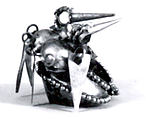Nose ornament
Not on view
Nose ornaments, usually suspended from the nasal septum, served as indicators of status and identity in antiquity. Made from precious metals, these objects were the focus of immense creative exploration in the first millennium of the Common Era. Metalsmiths from the highland Frías region of northern Peru made ornaments of metal sheet, but often shaped into fully three-dimensional forms, similar to styles found farther north. These objects bear a strong resemblance to pieces from the Tolita-Tumaco and Zenú cultures in Ecuador and Colombia. Indeed, studies have shown that metalworkers from the north brought their technological know-how to the Piura region, where they made gold objects reflecting their native iconographic traditions but using local raw materials.
Further reading:
Castillo, Luis Jaime. “Masters of the Universe: Moche Artists and Their Patrons.” In Golden Kingdoms: Luxury Arts in the Ancient Americas, edited by Joanne Pillsbury, Timothy Potts, and Kim N. Richter, pp. 24-31. Los Angeles: J. Paul Getty Museum, 2017.
Quilter, Jeffrey, and Alexis Hartford. "Nose Ornaments: A General Typology and Moche Case Study." Res: Anthropology and Aesthetics 77, no. 1 (2022), pp. 283-302.
Vetter, Luisa. “El gran hallazgo de 1956 en Piura: Nuevas preguntas sobre la metalurgia de los Andes centrales.” In Los desafíos del tiempo, el espacio y la memoria. Ensayos en homenaje a Peter Kaulicke, edited by Rafael Vega Centeno and Jalh Dulanto, pp. 505–41. Lima: Pontificia Universidad Católica del Perú, 2020.
Vetter, Luisa et al. “La técnica del cobre dorado en objetos de metal usados entre el 400 AC y el 450/500 DC en la Bahía de Huanchaco, costa norte del Perú.” Chungará 55 número 4 (2023): 681-701.
This image cannot be enlarged, viewed at full screen, or downloaded.

